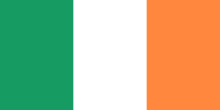Ireland
Ireland is an island off the north west coast of mainland Europe and the second biggest island in the British Isles. It shares a land border with the United Kingdom (Northern Ireland). The capital city is Dublin. Some other large cities are Limerick and Cork. Ireland is a member of the European Union and uses the Euro as its currency. Ireland is often known as the Republic of Ireland to avoid confusion with Northern Ireland which is part of the UK.


Ireland's History
editIreland has had an eventful history from prehistoric times until today,
The first people arrived in Ireland over 10,000 years ago and were a community of hunter-gatherers. Later, about 3000 years ago, the Celts began to arrive in Ireland. The present-day Irish are partly descended from the Celts. Because of the Irish language and descent from Celts, Ireland is one of the Celtic nations along with Scotland, Wales, Isle of Man, Cornwall and Brittany.
Ireland was also invaded many times by the Vikings, or Norsemen as they were called. The Vikings later began to settle in many places. Some of their more famous towns were Dublin, Wicklow, Waterford, Wexford and Limerick.
In later times, Ireland was invaded by the Normans and then the British, who ruled until the 20th century. Major events in Irish History including the Irish Famine in 1846-1851 and the Easter Rising in 1916, occurred during this period. During the 19th and early 20th century large numbers of people emigrated from Ireland, mostly to the USA but also to Australia, Canada and the UK.
The Republic of Ireland finally gained independence in December 1922. The country joined the European Union in 1973 (at the same time as the United Kingdom and Denmark). Since Ireland became independent there have been disagreements and violence over Northern Ireland. Northern Ireland remains part of the UK and many Irish people on both sides of the border believe that there should be a united Ireland. Since the 1970s there have been terrorist attacks, shootings and violence in Northern Ireland, Ireland, the UK and other countries. Today both parts of Ireland are generally peaceful.
Irish Famine — Between 1846 and 1851 millions of people in Ireland died and the country's population fell from about 8 million to 4-5 million because of deaths and emigration
Ireland's Geography
editThe largest mountain in Ireland is Carrauntoohil at 1,041 meters. It is in the MacGillicudy Reeks in Co. Kerry. Ireland is the only place in the world (apart from Scotland) where there are bogs. These are large plains where turf is extracted for fires. The EU have placed laws, preserving the bogs as it takes around 5,000 years for a bog to develop and they are extremely rare.
Ireland has been said to look like "a giant teddy bear" in the middle of the Atlantic Ocean. The Atlantic Ocean beats at the west coast, creating many islands and inlets by erosion. There are also a few interesting geographical sites, such as The Burren (Co. Clare) and the Giant's Causeway (Co. Antrim).
Ireland is divided into four provinces; Munster in southern Ireland has the most fertile land and is famous for its rugby team; Leinster where the British had most control in the 18th and 19th centuries; Connaught, the least fertile land in the country, and the most rural, and finally Ulster in the north of Ireland, most of which is still part of the United Kingdom.
These four provinces are divided into counties, the counties are bigger in Munster and Connaught and smaller in Leinster and Ulster. There are 32 counties altogether, six of which are still part of the United Kingdom.
The longest river in Ireland is the River Shannon which extended by canals forms a major transport route in the country.
Ireland's People
editThe population of The Republic of Ireland is 4.6 million (a further 1.5 million live in Northern Ireland). Most people in Ireland speak English but a large minority also speak Irish Gaelic.
Within the Republic 85 percent of the population is Roman Catholic. Ireland is one of the main Catholic countries in Europe along with Poland, Italy and Spain.
Some Famous Irish People
edit- The film actor Liam Neeson played Qui-Gon Jinn in Star Wars Episode I: The Phantom Menace.
- Ernest Walton from County Waterford (with his colleague, John Cockroft from England) won the Nobel Prize in Physics for splitting the atom.
- John Philip Holland designed and built the first Submarine for the US Navy.
- Bram Stoker wrote the famous horror story, Dracula.
Ireland's Sights
editIreland is extremely popular with tourists from around the world. The cities of Dublin, Cork, Galway and Belfast (in Northern Ireland) are popular throughout the year. There are 2 UNESCO World Heritage Sites in the Republic of Ireland - Skellig Michael in the south-west and Brú na Bóinne in the north-east. In addition, the Giant's Causeway in Northern Ireland is also a World Heritage Site.
| Wikijunior Europe • Intro • EU • Geo • People • Language • Facts • Quiz | edit | ||